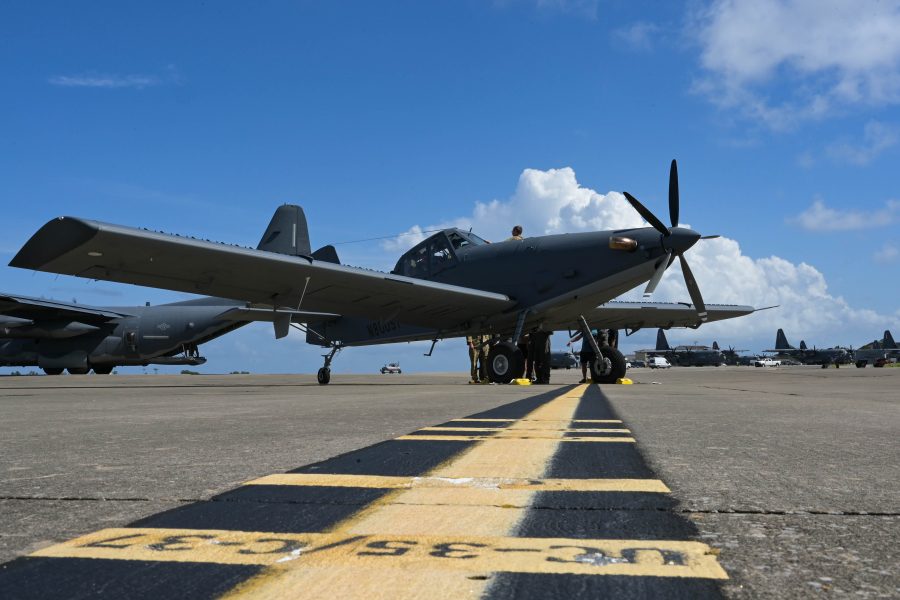Air Force Special Operations Command will find ways to use the OA-1K Armed Overwatch plane, said AFSOC Commander Lt. Gen. Michael E. Conley, setting aside questions about the fleet’s size and utility in a changing strategic environment.
The first operational aircraft will be delivered to AFSOC within months, but the world into which the command will welcome its militarized propeller-driven Air Tractors is markedly different from that of even a few years back, when the Air Force and U.S. Special Operations Command developed the requirements for a manned, lightweight, low-cost combat scout craft to do light attack, close air support, and intelligence, surveillance, and reconnaissance for counterinsurgency missions, replacing the U-28 Draco and the MC-12W Liberty.
SOCOM selected Sky Warden—an Air Tractor AT-802U cropduster modified for military use by L3Harris —in August 2022 with plans to buy 75 aircraft, but that plan was cut back to 62 aircraft earlier this year.
Delays followed. The first production aircraft was supposed to be delivered in October 2023, but Conley said Sept. 18 that he is now anticipating delivery in “the first quarter of [calendar year] ’25.”
“I think all new technology, new airframes, there’s always a little bit of a delay, they learn as they go,” Conley told reporters. He added that he’s seen “nothing that has me concerned with cost or delays,” beyond the lack of operational aircraft. “Once I have that, I’ll be more comfortable,” he said.
Pilots are familiarizing themselves now with a pair of standard issue Air Tractor 802Us at Will Rogers Air National Guard Base, Okla., Conley said. Those aircraft have none of the modifications L3Harris is installing on the Air Force planes, AFSOC confirmed.
As the Air Force gears up for peer competition in the Pacific, some have questioned the need for Armed Overwatch in that part of the world, but Conley suggested AFSOC will be inventive in applying the asset to all manner of scenarios.
“Once we get the aircraft and we start flying it, our crew members and our maintainers will figure out novel ways that it will be relevant in the future fight as well as the current one,” Conley said. “I tell my team every day, the Pacific is incredibly important to us for all the reasons [Secretary Frank Kendall] has said: China, China, China. We get it. But we’ve also got the rest-of-the-world mission that I’m responsible for, as well, and I want to have all the cards I can play to fight wherever they need us to.”
Just as AFSOC injected new applicability into the venerable C-130 by converting the cargo carriers into gunships like the AC-130, Conley sees an adaptable future ahead for the Air Tractors.
“I think it still provides a cost-effective close air support platform, which is one of the missions that it was designed for,” he said. “It’s still going to provide an ISR capability. But as we move forward, I think there’s opportunity to look at it against novel mission sets.”
That could include signals and electronic intelligence, Conley suggested, as well as crisis response, provided AFSOC can find a way to rapidly dismantle, transport, and reassemble the aircraft.
“What I’m telling industry right now is I need them to give me operational aircraft on time and on cost, and then the pathfinding mindset of folks at AFSOC will figure out what to do with it moving forward again,” he said.
Conley faces renewed scrutiny of the program after the General Accountability Office issued a new, mostly classified report Sept. 5 reiterating concerns first expressed in December 2023 that SOCOM failed to justify the need for 75 planes and urged the Pentagon to slow down purchases until the command completed a comprehensive analysis.
SOCOM’s decision to cut the buy to 62 aircraft was disclosed in the president’s 2025 budget request, the result of “resource constraints” rather than a broader change in plans, the command said at the time. Conley said this month that he still supports a fleet of 75 OA-1K aircraft, justified by the intended mission set and unstated potential future uses.
“It is possible that we don’t buy those 75 in the same time frame that we wanted to,” he said. “But that’s still our requirement.”


